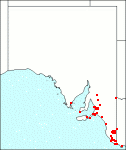|
Trifolium resupinatum
Citation:
L., Sp. Pl. 771 (1753) var. resupinatum.
Synonymy: T. clusii Godr. & Gren. in Gren. & Godr., Fl. Fr. 1:414 (1848); T. resupinatum L. var. minus Boiss., Fl. Orient. 2:137 (1872).
Common name: Shaftal clover, reversed trefoil
Description:
Glabrous (except for the calyx) annual; stems prostrate or ascending or erect, 10-60 cm long; petioles of lower leaves slender, 3-6 cm long, upper sometimes hardly c. 5 mm long; leaflets on short petiolules, sometimes articulate, obovate, cuneate, 7-40 mm long, veins simple or once-forked and projecting from the margin as a hooked mucro; stipules lanceolate, 3-15 mm long, distinctly veined, membranous.
Flowers resupinate, 7-10 mm long, subsessile, 10-25 in a head, on peduncles less than twice as long as the subtending leaves; lower flowers subtended by small scarious scalelike minute bracts forming a deeply dissected irregular involucre, less than 0.5 mm long, upper flowers lacking bracts; heads globose, 10-15 mm wide in flower, to 20 mm in fruit; calyx 10- or rarely 20-nerved, campanulate at first, c. 2 mm long; teeth unequal; upper 2 longer, subulate-acuminate, protruding sideways, villous on the upper lip which becomes inflated and elongates unilaterally over the lower 3 teeth into an obliquely ovoid hairy or glabrescent net-veined bladder 6-10 mm long; lower 3 teeth lanceolate and glabrescent, unchanged at the fruiting stage; petals pink, rarely reddish-purple; standard oblong, notched, one-third longer than the wings, exserted, persistent; wings longer than the keel.
Pod enclosed, ovate, c. 2 mm long, soft-leathery, brown, 1- rarely 2-seeded; seed cordate, c. 1 mm long, longer than wide, green-brown, smooth.
Published illustration:
Zohary (1972) Flora Palaestina 2:244, 245.
|
|
Distribution:
|
W.Aust.; N.S.W.; Vic.; Tas. New Zealand; possibly native to southern Europe, sometimes cultivated.
|
Conservation status:
naturalised
Flowering time: Sept. — Feb.
|

SA Distribution Map based
on current data relating to
specimens held in the
State Herbarium of South Australia
|
Biology:
No text
Taxonomic notes:
Coombe (1968), Flora Europaea 2:165, commented that it is "Very variable in habit and size of its parts"; he accepted var. majus Boiss., Fl. Orientalis 2:137 (1872) but did not mention var. minus Boiss. Boissier included T. clusii as a synonym of the latter variety.
Author:
Not yet available
|

